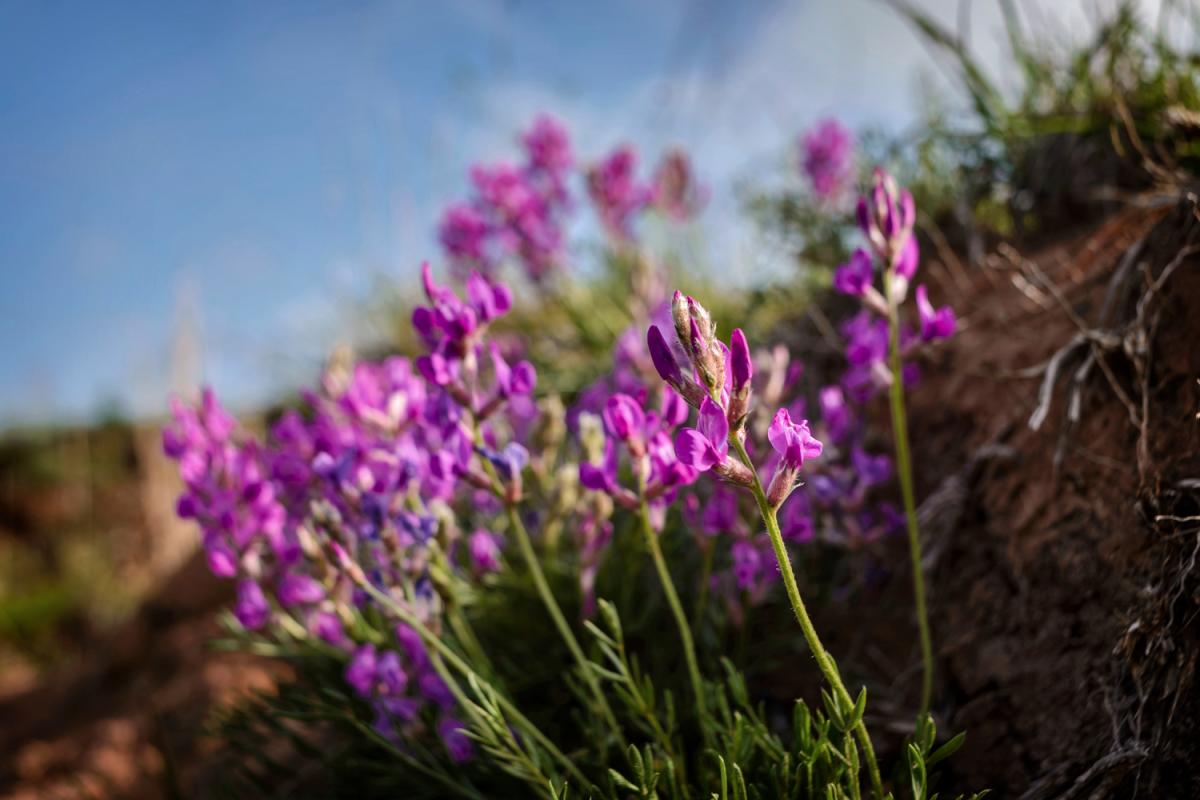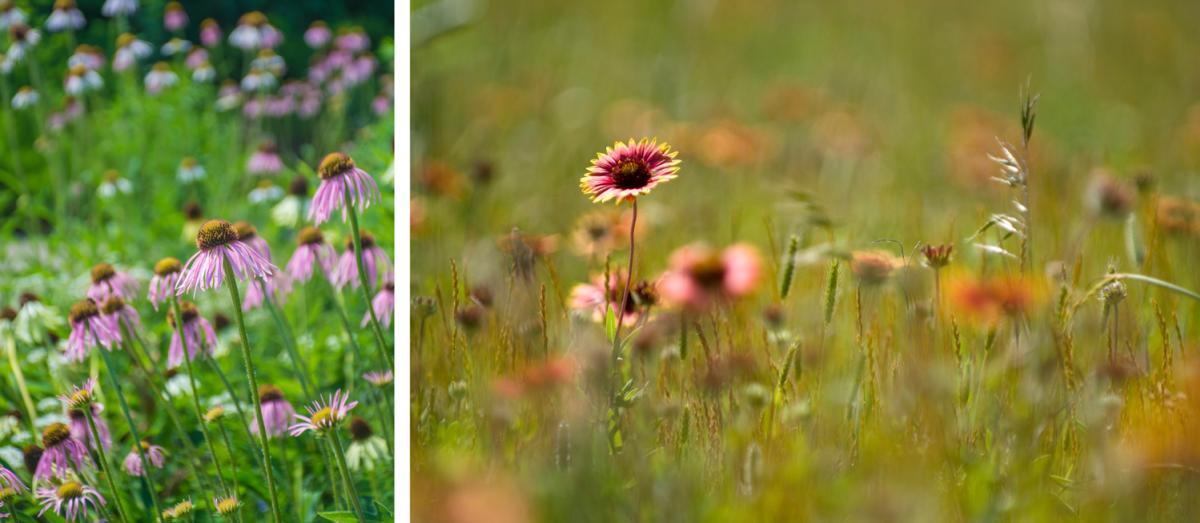
Save money and the planet with these backyard grasses
The subtle beauty of dusk is one of the best times to appreciate the sights and sounds of the Kansas prairie. The landscapes, native grasses and plants that stretch before us nurture our souls and provide a moment of pause in the chaos of life.
Sure, you can take a drive out along the backroads any time you want, to gaze at the prairie. But why not nurture a bit of prairie in your own yard?
From buffalo grass to blue grama and switchgrass, it all depends on what your goals are and how much annual rainfall your region of Kansas can expect, says Brad Guhr, education/prairie restoration and concert series coordinator for Dyck Arboretum of the Plains in Hesston.
One option is to substitute Kentucky bluegrass—a cool-season grass that requires frequent waterings—for buffalo grass, which requires less water. As some areas of Kansas experience water shortages, doing our part to conserve benefits not just ourselves and our neighbors but the whole state.
By using native plants and grasses, Guhr says we could be more ecologically friendly and have great, colorful yards and gardens.
“Given our climate, the sunlight, average temperatures and rainfall, we best support warm-season grasses,” he says.
Historically, Kansas has “short grasses in western Kansas, mixed-type grasses in central Kansas and tall grasses in the east,” Guhr says.
The pioneers often described the lushness of the prairie. Hattie Gibbons wrote a description of what the prairie looked like in 1876 when she and her husband, William, first homesteaded in the Ninnescah valley, east of Pratt: “The prairie was covered with a green carpet of grass, and here and there in the low places the flowers bloomed all summer long … I lived in a vast garden and in between the beds were long avenues of (green) stretching away to the horizon … I felt relaxed and had a sense of freedom.”

You, too, can create your own swatch of prairie, Guhr says. It just depends on what your goals are. Native plants and grasses provide great habitats for wildlife—birds and bees, and other critters, seek out berries, seeds, nuts and nectar.
The native plants and grasses “are all dominated by warm-season grasses because of our temperatures and sunlight—that’s what has evolved on the plains for the last 10,000 years.
“When you live in the rain shadow of the Rockies, you didn’t have much shade in Kansas,” Guhr says. “But when you get into situations of shade, it’s harder to grow warm-season grasses because then you get microclimates where cool-season grasses and sedges might do better. It’s not an easy answer to what seems like a simple question.”
Going back to the roots
Some towns in Kansas recommend strategies that save on their city’s water use. In cities such as Hays, residents are encouraged to grow warm-season grasses such as buffalo grass and Bermuda whenever possible. Newly seeded lawn permits in Hays are free for those type of grasses, but they cost $100 if cool-season grasses such as tall fescue and Kentucky bluegrass are seeded during the water-restricted months of June and July, according to the website, haysusa.com.
Buffalo grass requires less mowing, watering and fertilizing, but it is not perfect for every region of Kansas, Guhr notes.
“We are trained aesthetically to have this English landscaping mindset,” he says. “Buffalo grass is adapted to grow in areas that get five to 10 inches of rainfall, such as in western Kansas. So, what’s going to happen when you try to grow buffalo grass in central Kansas, where you can receive 25 to 30 inches of rainfall? Those other plants and weeds that like those higher rainfall conditions are going to continually invade your turf because buffalo grass doesn’t like that much water.” Those invasive plants and weeds? Think ragweed, foxtail and crabgrass.
Native plants and grasses, Guhr says, are often the most ecologically friendly choice for many reasons such as erosion control, water saving and even labor.
“Not only are you saving water, but you are also talking about attracting biodiversity,” Guhr says. “It’s the insects, the critters who eat the insects—that’s why your goals matter a lot. Do you want the most biodiversity possible—which would mean you plant as many different species of plants as possible to get towards a prairie? Do you want a diverse prairie, or do you want to temper your goals on biodiversity to please homeowners associations and neighbors who aren’t used to wild-looking landscapes? So, instead of choosing 50 species of native plants and grasses, let’s choose five to 10 and plant them in aesthetically pleasing ways like in clumps of threes, fives and sevens—like the landscape architects will talk about.”
In the future, Kansans might expect to see more prairie plots.
One program, sponsored by the Kansas Native Plant Society, has the “Plant a Prairie Program.” It encourages schools and public gardens to grow their own plot of prairie. Each garden receives about 10 to 12 packets along with sowing instructions. The application process begins in the spring; the gardens start in the fall when native plants are delivered to the schools.
Flowering seas of color
For splashes of color in garden areas, Guhr says, try butterfly milkweed, a splashy, bright orange plant that dots the Flint Hills and is drought-resistant. It attracts bees, and monarch butterflies lay their eggs on it, Guhr says.
Milkweed varieties in other regions of Kansas, such as those found further west are yellow and deep brick red near the Nebraska/Kansas border. Echinacea, also know as the purple coneflower and Black Sampson, is a wonderful flower. And penstemon is another. Think of your garden and yard as Mother Nature’s palette filled with colors where sunflowers, goldenrods and gayfeathers burst forth, turning your piece of the prairie into a quilt of yellows, golds and purples.
And with a little planning, asters could join them in the fall.
Late summer is the season of everlasting, a white flowering plant that American Indians traditionally gathered and used to treat colds and coughs. It smells like vanilla and maple syrup. Late summer is also the time for Jerusalem artichokes, a plant that blooms like the sunflower and has edible tubers.
You could also consider grasses such as little bluestem, big bluestem, switchgrass, Indiangrass and purpletop. It’s not unusual to see splashes of orange, red, purple, blue, white and yellow as Kansas wildflowers take bloom from early summer through fall.

Some plants springing up in the wild may not have flowers but are delicious to eat. Lambs quarters, a dusty green plant with goose-foot-shaped leaves, is nutritious and can be eaten like spinach or kale—mixed in salads, sauteed with other vegetables or used in soups.
Early settlers looked for lambs quarters because it is one of the first plants to sprout in the spring and early summer. Daisy fleabane is almost everywhere, including ditches and pastures. Early pioneers collected the flowers to rid homes and campsites of fleas and other unwanted pests.
Tall flowering plants like the flannel mullein plant with its yellow showy flowers can grow to more than seven feet tall. Short ones such as the catclaw sensitive briar grow close to the ground, as does the purple poppy mallow, sometimes known as winecups.
Some plants are at their best in the early morning and close their petals as the day wears on, such as the common spiderwort. That’s the beauty of the Kansas prairie.
“It is a relevant consideration, the more diversity you get,” Guhr says, the more you can expect to see.




